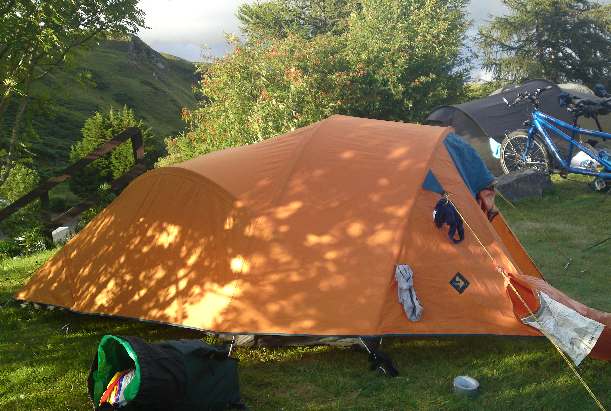More information about donations to cyclecamp here.
More information about donations to cyclecamp here.

Cyclecamp resource page 010

Tents today are light, cheap, strong and roomy. Cycle camping has never had it so good. Just don’t expect to be able to stand up in one!
Tents come in all shapes and sizes but what cycle campers really care about is how heavy they are! One person camping alone can carry a small tent up to about 2.5 kg but not much more. It’s possible to find tents that weight much less than this – 1.5 kg for example – which will be ideal for longer distances.
You probably won’t be able to stand up in a tent that is light enough for cycle camping but you should at least be able to sit up and eat or change your clothes. Having a porch to store your wet gear in or even just your shoes is also really helpful.
When two or three people go camping together the available space can enlarge dramatically – you can even think about storing your bicycles inside the tent.
Tents are often wrongly labelled “two-man” (and yes, women and girls also go camping!) but will often only be big enough for one person and their luggage. That luggage will almost always have to go inside your tent to keep it away from animals, other people and the weather. So make sure that your tent is big enough for both you and your stuff.
Tents come in three basic styles: domes, hoops and ridges. Each has its advantages:
Domes give you lots of headroom and can be picked up and moved.
Hoops are similar but give a better overall (longer) shape. Single hoop tents create a roomy but small and light design.
Ridge tents are the traditional shape: they don’t have as much headroom as a dome but they are very strong in a gale and easy to put up.
All these tents weigh and cost about the same. And all of them almost always, except for the very cheapest tents, have an inner tent and an outer tent. The outer tent is called the fly sheet - not to be confused with the mosquito netting that is makes up part of the inner tent walls or door.

Not all nylon and polyester tents are of the same quality and you can pay anything from £20 up to more than £1000

The shape of tents changed radically about thirty years ago - and so did the material they were made from. Thanks to pioneers like Robert Saunders, tents made use of innovative man-made fibres like nylon and polythene. These man-made materials dramatically reduced the weight of tents.
Up until then, they used a thick cotton material called cotton canvas which was even heavier after a rainy night. Nylon isn't a very warm or comfy material for a tent: cotton is still the comfiest and doesn’t suffer so much from condensation. But cotton is heavy so tents that are the right size and weight for cycle camping are now exclusively nylon.
Not all nylon tents are of the same quality and you can pay anything from £20 up to more than £600 for one that will withstand gale force winds at high altitudes.
Somewhere in between these two extremes, expect to pay about £70 - £80 for the right tent for cycle camping in the UK. The price will determine the quality of the nylon, how waterproof it really is (measured by the “hydrostatic head”) and whether the seams are taped.
A useful feature in a tent is whether it can be pitched “fly sheet first”. This means you can get under cover to pitch the inner without it getting wet. And beware - nylon degenerates if left out too long in the sunshine.
By the way, making tents lighter has led to ground sheets becoming very thin so it is now possible to buy a “footprint” to protect the ground sheet, thus losing some of the weight saving. An old sheet of polythene would also be good for protecting your ground sheet from mud and stones.
Tent pegs can now be made of plastic or even titanium but aluminium pegs should be light enough. Be realistic about how light you want to camp: for high mileages you will have to sacrifice some comfort and space but for lower mileages your tent should be a really comfortable home, rain or dry, for the length of your tour. Get to know your tent and how to pitch it before you camp – a rainy night in the garden will help to give you a realistic idea of how it will perform (and it will also tighten up the fibres in the tent material).
Good makes of tent include Robert Saunders, Vango, Vaude, Terra Nova, Coleman and Hilleberg. Cotswold Outdoor has a wide range of good value tents suitable for cycle camping. Check them out in the cyclecamp shop.

cyclecamp
the joined up cyclecamping network